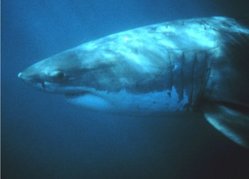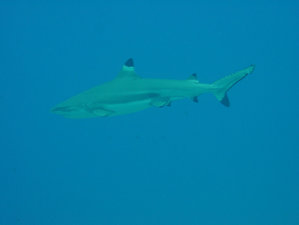Shark
Sharks are a group (superorder Selachimorpha) of fish, with a full cartilaginous skeleton, a streamlined body plan, with normally 5, but up to 7 (depending on species) gill slits along the side of, or beginning slightly behind, the head (in some species, a modified slit called a spiracle, is located just behind the eye), dermal denticles covering the body to protect from damage, parasites and improve fluid dynamics, and rows of replaceable teeth in the mouth. more...
Characteristics
Sharks have keen olfactory senses, with some species able to detect as little as one part per million of blood in seawater. They are even more attracted to the chemicals found in the gut of many species, and often linger near or in sewage outfalls. Some species, such as Nurse Sharks, have external barbels that greatly increase their ability to sense prey. Shark eyes are similar to the eyes of other vertebrates, including similar lenses, corneas and retinas, though their eyesight is well adapted to their marine environment with the help of a tissue called, tapetum lucidum. This tissue is behind the retina and reflects light back to the retina, thereby increasing visibility in the dark waters. The effectiveness of the tissue varies, with some sharks having stronger nocturnal adaptations. Sharks have eyelids, but they do not blink because the surrounding water cleans their eyes. To protect their eyes some have nictitating membranes. This membrane covers the eyes during predation, and when it is being attacked. Sharks generally rely on their superior sense of smell to find prey, but once they are close they also use the lateral lines running along their sides to sense movement in the water and also employ special sensory pores on their heads (Ampullae of Lorenzini) to detect electrical pulses created by the muscles of prey. Their teeth are not attached to the jaw, but embedded in their flesh, and in many species are constantly replaced throughout the shark's life. The lower teeth are primarily used for holding prey, while the top are used for cutting into it. (Gilbertson, 7.3)
There are exceptions to the "large", "marine" (as in 'ocean-going') and "predatory" portions of the characterization. Sharks include everything from the hand-sized Pygmy Shark, a deep sea species, to the Whale Shark, the largest fish (although sharks are not closely related to bony fish) which is known to grow to a maximum length of approximately 15m (49 feet) and which, like the great whales, feeds only on plankton. Although not unique among sharks, the Bull Shark is the better known of several species to regularly swim in both salt and fresh water environments (most famously in Lake Nicaragua, in Central America) and in most deltas. A few of the larger species, the Mako and White Shark, are mildly homeothermic, able to maintain their body temperature at a level above the ocean's temperature. This is possible because of the presence of the rete mirabile, a counter current exchange mechanism that reduces the loss of body heat.
Like other fish, sharks extract their oxygen from seawater as it passes over their gills. Due to their size and the nature of their metabolism, sharks have a higher demand for oxygen than most fish and they cannot rely on ambient water current to provide an adequate supply of oxygenated water. If a shark were to stop swimming, the necessary water circulation for respiration would become too low and the animal could suffocate. Some sharks, like the Blacktip Reef Shark and Nurse Shark, can pump water over their gills as they rest. There are also known instances, such as in certain caves along the Yucatan coast, where sharks of varying species rest on the cave floors and allow the fresh water outflow to pass over them. The outflow is strong enough to allow for respiration, and it is believed that the reason for this behaviour is that the fresh water helps remove certain parasites. Also, unlike other fish, sharks do not have gas-filled swim bladders, but rather rely on an oil-filled liver for (limited) buoyancy, so they sink when they stop swimming; a resting shark always sinks to the sea bed.
A shark, if inverted, enters a natural state of paralysf time. Researchers use this condition for handling sharks safely.
A popular myth is that sharks are immune to disease and cancer, however, this is untrue and there are both diseases and parasites that affect sharks. The evidence that sharks are at least resistant to cancer and disease is mostly anecdotal and there have been few, if any, scientific or statistical studies that have shown sharks to have heightened immunity to disease.
Shark Attacks
The fear of sharks has been fueled worldwide by a few unusual instances of unprovoked attack, such as the Jersey Shore Shark Attacks of 1916, and by sensationalized fiction and film, such as the Jaws series. While sharks cause a few dozen human deaths annually, it is relatively not a large number (e.g. several hundred people die anually struck by lightning; however, lightning may strike anywhere worldwide, whereas only a very small part of human population is susceptible to shark attacks, i.e. only those people who enter the water in the areas populated by sharks).
Contrary to popular belief, only a few sharks are dangerous to humans. Out of the more than 360 described species of sharks, only 4 have been confirmed to have killed humans: the Great White, Tiger, Bull, and Oceanic Whitetip sharks. These sharks, being large, powerful predators perfectly capable of eating humans, will sometimes attack and kill people, but all of the above sharks, even the Great White, have been filmed in open water, with no cage, time and time again, without incident. There are many theories about why sharks attack people. Some claim that the shark is confusing a human for a seal or other prey animal; this would be typical in the case of an attack against a surfer. Often the shark that attacks a human will make only one bite and then go away. This behaviour has many possible explanations, one being that humans don't taste good (or at least, as good), or are lacking the necessary fat, and another being that sharks normally make one swift attack, and then retreat and wait for the victim to die, or exhaust itself, before it comes back to feed. This protects the shark from retribution from a wounded and aggressive target, but also allows humans the time to get out of the water and survive.
Read more at Wikipedia.org



